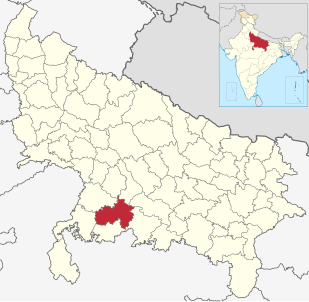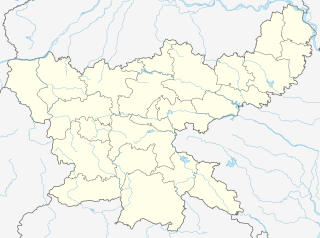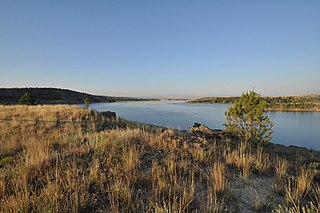Related Research Articles

The Rio Grande is one of the principal rivers in the southwest United States and northern Mexico. The Rio Grande begins in south-central Colorado in the United States and flows to the Gulf of Mexico. Along the way, it forms part of the Mexico–United States border. According to the International Boundary and Water Commission, its total length was 1,896 miles (3,051 km) in the late 1980s, though course shifts occasionally result in length changes. Depending on how it is measured, the Rio Grande is either the fourth- or fifth-longest river system in North America.

The Colorado River is an 862-mile (1,387 km) long river in the U.S. state of Texas. It is the 18th longest river in the United States and the longest river with both its source and its mouth within Texas.

The Tongue River is a tributary of the Yellowstone River, approximately 265 mi (426 km) long, in the U.S. states of Wyoming and Montana. The Tongue rises in Wyoming in the Big Horn Mountains, flows through northern Wyoming and southeastern Montana and empties into the Yellowstone River at Miles City, Montana. Most of the course of the river is through the beautiful and varied landscapes of eastern Montana, including the Tongue River Canyon, the Tongue River breaks, the pine hills of southern Montana, and the buttes and grasslands that were formerly the home of vast migratory herds of American bison. The Tongue River watershed encompasses parts of the Cheyenne and Crow Reservations. The Headwaters lie on the Big Horn National Forest, and the watershed encompasses the Ashland Ranger District of the Custer National Forest.
Tongue River may refer to:
The voiced uvular implosive is an extremely rare type of consonantal sound. The symbol in the International Phonetic Alphabet that represents this sound is ⟨ʛ ⟩, a small capital letter G with a rightward pointing hook extending from the upper right of the letter.
Chipewyan, ethnonym DënesųłinéIPA: [ tènɛ̀sũ̀ɬìnɛ́], is the language spoken by the Chipewyan people of northwestern Canada. It is categorized as part of the Northern Athabaskan language family. Dënesųłiné has nearly 12,000 speakers in Canada, mostly in Saskatchewan, Alberta, Manitoba and the Northwest Territories. It has official status only in the Northwest Territories, alongside 8 other aboriginal languages: Cree, Dogrib, Gwich'in, Inuktitut, Inuinnaqtun, Inuvialuktun, North Slavey and South Slavey.
Flutter-tonguing is a wind instrument tonguing technique in which performers flutter their tongue to make a characteristic "FrrrrFrrrrr" sound. The effect varies according to the instrument and at what volume it is played, ranging from cooing sounds on a recorder to an effect similar to the growls used by jazz musicians.

Kangri is an Indo-Aryan language variety spoken in northern India, predominantly in the Kangra, Hamirpur and Una districts of Himachal Pradesh and in the Gurdaspur and Hoshiarpur districts of Punjab. It is associated with the people of the Kangra Valley. The total number of speakers has been estimated at 1.7 million, while those who reported their first language as Kangri in the 2011 census were 1.17 million.

Hamirpur district is one of the 75 districts of Uttar Pradesh state of India and Hamirpur town is the district headquarters. Hamirpur district is a part of Chitrakoot Division. The district occupies an area of 4,121.9 km². The district has a population of 1,042,374. As of 2011 it is the third least populous district of Uttar Pradesh, after Mahoba and Chitrakoot. Two major rivers Yamuna and Betwa meet here. On the banks of river Betwa lies the "Coarse sand" which is exported to many parts in U.P.

The Northern Cheyenne Indian Reservations is home of the federally recognized Northern Cheyenne Tribe. Located in southeastern Montana, the reservation is approximately 444,000 acres (1,800 km2) in size and home to approximately 5,000 Cheyenne people. The tribal and government headquarters are in Lame Deer, which is also the home of the annual Northern Cheyenne Pow wow. The reservation is bounded on the east by the Tongue River and on the west by the Crow Reservation. There are small parcels of non-contiguous off-reservation trust lands in Meade County, South Dakota, northeast of the city of Sturgis. Its timbered ridges that extend into northwestern South Dakota are part of Custer National Forest and it is approximately 40 miles (64 km) east of the site of the 1876 Battle of the Greasy Grass.

Arki is one of the administrative community development block of Khunti district, Jharkhand state, India.
Of the languages spoken in Texas none has been designated the official language. Around two-thirds of Texas residents speak solely English at home, while another 29.10% speak Spanish. Throughout the history of Texas, English and Spanish have at one time or another been the primary dominant language used by government officials, with German recognized as a minority language from Statehood until the first world war.
Lake Texana is a reservoir on the Navidad River, 8 miles (13 km) east of Edna, in Jackson County, Texas. The reservoir is formed by the construction of Palmetto Bend Dam. The dam and lake are managed by the Lavaca-Navidad River Authority, and supply water to surrounding communities and industries. Lake Texana is the only reservoir managed by the Authority.

The Pease River is a river in Texas in the United States; it is a tributary of the Red River that runs in an easterly direction through West Texas. It was discovered and mapped for the first time in 1856 by Jacob de Córdova, who found the river while surveying for the Galveston, Houston and Henderson Railroad Company; it was named after Texas Governor Elisha M. Pease. In December 1860, the Texas Rangers recaptured Cynthia Ann Parker and her daughter from the Comanche Indians at an engagement along the river.
Berik is a Papuan language spoken in eastern Papua. Speakers are located in four village groups on the Tor river towards the northern coast of Indonesian-controlled Irian Jaya. US linguist John McWhorter cited Berik as an example of a language which puts concepts "together in ways more fascinatingly different from English than most of us are aware". Illustrating this, in the phrase Kitobana, affixes indicating time of day, object number, object size, and gender of recipient are added to the verb.

Tongue River Reservoir State Park is a public recreation area located 6 miles north of Decker, Montana, on the western shore of the Tongue River Reservoir. The 12-mile-long reservoir is an impoundment of the Tongue River. The state park, occupying 642 acres at an elevation of 3468 feet, offers boating, fishing, camping, swimming, wildlife viewing, and a seasonal marina.

Campfire on the Road is the thirty-second album by American singer-songwriter Michael Martin Murphey, his second solo performance album, and his fourth live album. The album was recorded live February 28 and March 1, 2011 at the Western Jubilee Warehouse Theater in Colorado Springs, Colorado, and was released February 21, 2012.
Sierra Leone is a multilingual country. English is the de facto official language, and Krio is the most widely spoken.
References
- "An Analysis of Texas Waterways" . Retrieved 2006-05-04.
- USGS Geographic Names Information Service
- USGS Hydrologic Unit Map - State of Texas (1974)
| This article related to a river in Texas is a stub. You can help Wikipedia by expanding it. |